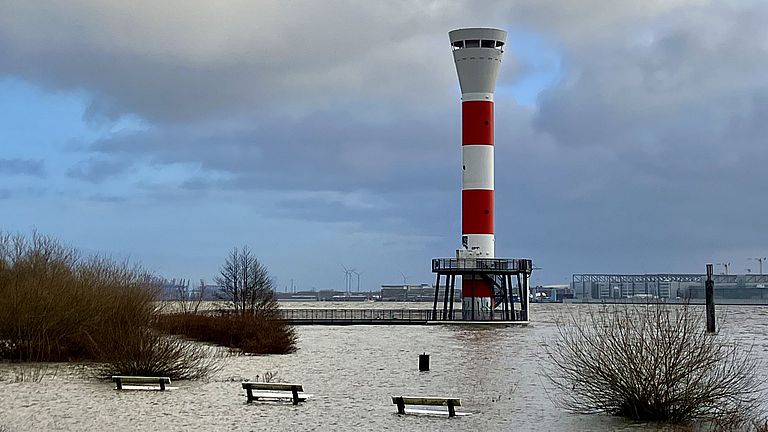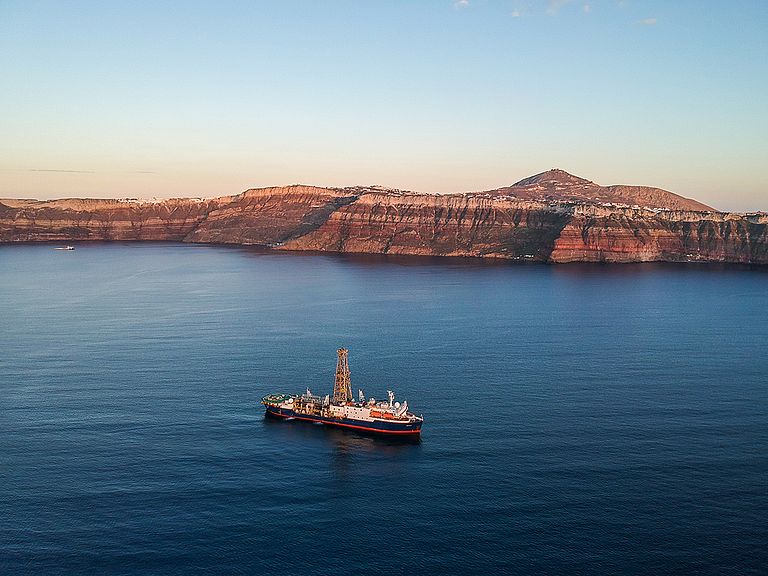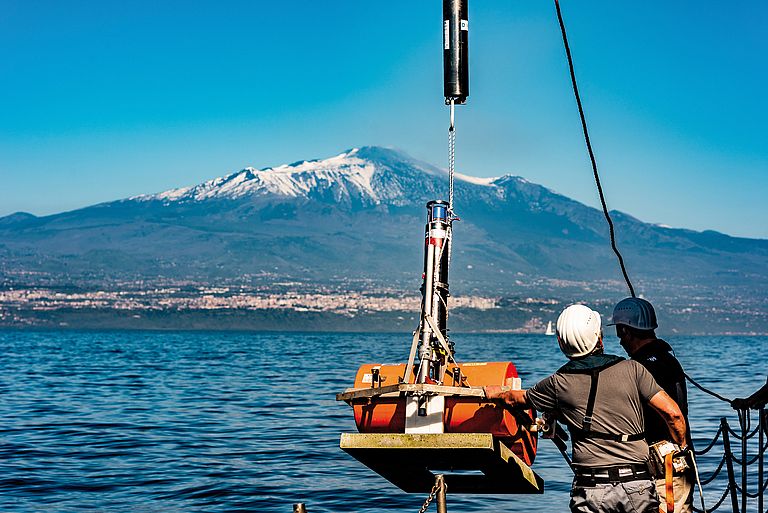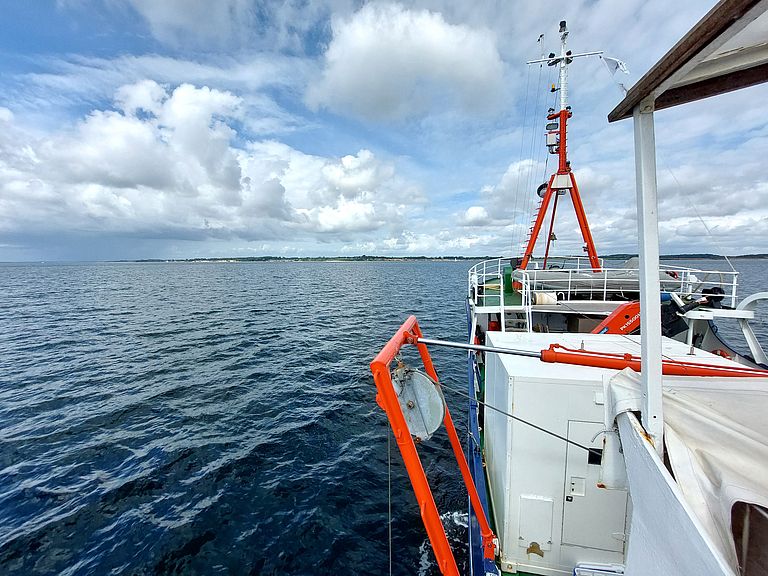Understanding extreme marine events and natural hazards in Europe
GEOMAR coordinates two joint projects of the now launched third research mission of the German Marine Research Alliance and participates in two others
Coastal areas and communities are increasingly exposed to marine natural hazards and extreme events – with mostly regional, but also far-reaching global consequences. These include floods and storm surges, which often cause enormous damage to coastal buildings and infrastructure, as was the case in Germany in 2023. Coastal regions in particular are massively affected by rising temperatures and the resulting feedback effects. These are, for example, triggers for the increased occurrence of microorganisms that can harm humans and animals, and for oxygen scarcity, which can lead to mass fish mortality. In other regions of the world, tsunamis triggered by earthquakes or volcanic eruptions cause massive flooding and coastal disaster conditions.
Individual extreme events and natural hazards can be exacerbated if they occur simultaneously or in quick succession and interact with each other, leading to cascading, far-reaching socio-economic impacts. The interactions of these often multiple extreme events and natural hazards and their long-term effects on marine ecosystems and coastal populations are the focus of the third inter- and transdisciplinary research mission of the German Marine Research Alliance (Deutsche Allianz Meeresforschung, DAM) “Pathways to improved risk management in the field of marine extreme events and natural hazards” (mareXtreme).
The aim of mareXtreme is to significantly improve the predictive capacity for extreme marine events and natural hazards, to support the sustainable development of coastal communities and to strengthen the resilience of coastal society. As in the first two DAM research missions “Marine carbon sinks in decarbonisation pathways” (CDRmare) and “Protection and sustainable use of the ocean” (sustainMare), researchers from various disciplines also work together in close coordination with stakeholders from politics, business and civil society in mareXtreme. The aim is to enhance socially reflected, solution-orientated knowledge and enable science-based decisions to address extreme marine events and natural hazards.
GEOMAR Helmholtz Centre for Ocean Research Kiel coordinates two of the four joint projects of mareXtreme. In addition, GEOMAR researchers are also involved in the two other consortia. GEOMAR is also heavily involved in the CDRmare and sustainMare missions, which have been running since 2021.
“GEOMAR's significant participation in the third research mission of the German Marine Research Alliance builds on our expertise in assessing risks to Europe’s growing society caused both by climate change and geological processes,” says Professor Dr Katja Matthes, GEOMAR Director and member of the DAM Executive Board. “For GEOMAR, the collaboration within the DAM missions opens up new relationships between scientific disciplines and beyond, with politics, practice and society. We are very happy to be involved in mareXtreme in order to jointly develop solutions for future challenges.”
MULTI-MAREX – Addressing geo-risks in the Mediterranean
Under the leadership of Professor Dr Heidrun Kopp, geophysicist at GEOMAR, 50 researchers from eight universities and two Helmholtz centres are working closely together with society in the joint project MULTI-MAREX to improve forecasting options and approaches for action in the Mediterranean. In this way, they help to reduce the risks posed by geo-marine extreme events. One focus of the work is on the Aegean Sea. The region is one of the most tectonically active areas in Europe. It was chosen as a representative example of many coasts where an increase in population density and tourism exacerbates risks from geological processes such as earthquakes, volcanic eruptions and tsunamis. MULTI-MAREX brings together civil society and science under real-life conditions in order to prepare the local population and tourists for such events.
“We do not only want to characterise geological processes such as seaquakes and volcanism as well as flank stability and tsunamis more clearly, but also ensure more effective early warning,” says Professor Heidrun Kopp. “To this end, we brought together researchers from different disciplines who will work closely with the authorities and the local population in the sense of co-design.”
The work includes experiments on land as well as several ship expeditions, including to the undersea volcano Kolumbo. It is located around seven kilometres north-east of Santorini, in the direct vicinity of one of the region’s most important tourist destinations. Repeated earthquakes beneath the volcano suggest that magma is rising, making this volcano one of the most potentially dangerous ones in Europe.
“We will install an innovative monitoring system based on artificial intelligence and underwater communication at Kolumbo. This will allow us to draw conclusions about the interactions between multiple extreme events, for example how a volcanic eruption or a flank collapse results in a tsunami,” says the project coordinator. “From our research results and observations, we then generate valuable knowledge for action to support civil society in the sustainable development of protective measures and thus effectively protect not only coastal communities but also tourist centres from extreme events.”
ElbeXtreme - Understanding the effects of extreme events on ecosystem services
GEOMAR marine chemist Professor Dr Eric Achterberg coordinates the ElbeXtreme project, which investigates the effects of physical-oceanographic extreme events on ecosystem services in the Elbe estuary. In addition to a growing population, this region already experiences major changes in the ecosystem. Floods caused partly by storms and partly by heavy rainfall, droughts and heatwaves as well as combinations of different extremes are drive these changes with increasing intensity due to climate change. Science, politics and society are therefore challenged to assess the risk potential for coastal societies and to develop adaptation strategies. ElbeXtreme involves 40 researchers from 14 institutions.
ElbeXtreme will thoroughly analyse the consequences of extreme events on ecosystems and ecosystem services in the Elbe estuary and the German Bight as well as the associated risks. “We will combine data from the relevant measurement infrastructure that already available in the area with new observation strategies in order to characterise the physical, chemical and biological state of the Elbe, its estuary and its discharge into the North Sea,” explains Professor Dr Eric Achterberg.
The analysis of existing and new data using machine learning and their integration into coupled models and a digital twin of the Elbe will significantly improve the understanding of changes in ecosystem services during and after extreme events. This knowledge is a key prerequisite for improved predictions of possible medium and long-term changes in coastal ecosystems caused by extreme events and forms the basis for decisions on the necessary ecological, social and economic consequences, warning services and societal adaptations.
Participating researchers already organised an initial mission on short notice over the turn of the year, reports Professor Dr Eric Achterberg: “The ElbeXtreme team has been working since Christmas 2023 to investigate the effects of the recent flooding on the transport of nutrients and pollutants in the Elbe and their consequences for ecosystems. In the coming weeks, we will go out the research cutter LITTORINA in the German Bight between Cuxhaven and Helgoland to take further samples. The spontaneous operation was an excellent start to our practical work and provides us with valuable data right from the start.”
PrimePrevention – better assessment of biological hazards from the sea
The joint project PrimePrevention, coordinated at the Alfred Wegener Institute, Helmholtz Centre for Polar and Marine Research, aims to monitor and predict biological hazards from the sea, such as cyanobacteria blooms, the growing occurrence of Vibrio bacteria and loss of oxygen. Rising water temperatures increase the associated risks to human health and ecosystems as well as their potential negative economic impacts for Europe. The project will provide policy makers and society with important information for adapted marine monitoring and assessment strategies. More than 30 experts in measurement sensor technology, social research, geochemistry and microbiology are involved.
GEOMAR researchers are contributing findings on the temporal and spatial expansion of water masses in the Kiel Bight with low oxygen concentrations and hydrogen sulphide content. These can be emitted from the seabed into higher layers and, among other impacts, cause mass mortality of fish. “For the occurrence of such upwelling events, a detailed spatial probability map needs to be created as a first step to identify affected regions and provide a risk assessment for stakeholders. This relevant both for stakeholders from tourism, fisheries and aquaculture as well as for people living in the region,” explains Professor Dr Mirjam Perner, geomicrobiologist at GEOMAR. In order to collect data for the probability map, geochemical and microbiological data from the water column and sediment are collected on various expeditions.
METAscales – multi-scale modelling for improved risk management
In the METAscales project, which is coordinated by the Technical University of Braunschweig, scientists want to quantify potential damage and losses from extreme marine scenarios and improve strategies. This should help to reduce disaster risks and make coastal communities more adaptive and resilient. Among other activities, living laboratories with stakeholders from coastal communities and authorities are planned for implementation.
GEOMAR supports this with quantifications of marine heat waves and extreme sea level events as well as studies on atmospheric and oceanic drivers of these extremes. “We use our models to look into the past and into the future,” explains Professor Dr Arne Biastoch, ocean modeller at GEOMAR. “Our results are then integrated into other METAscales work packages that analyse these events and their effects at a high regional resolution or develop scenarios for describing possible futures.”
Background: German Marine Research Alliance:
The German Marine Research Alliance (DAM) brings together 24 leading German marine research institutions with the aim of strengthening the sustainable management of coasts, seas and the ocean through research, transfer, data management and digitalisation as well as infrastructures. To this end, the DAM and its member institutions develop solution-orientated knowledge and communicate options for action in politics, business and civil society. It is funded by the federal government and the northern German states of Bremen, Hamburg, Mecklenburg-Western Pomerania, Lower Saxony and Schleswig-Holstein.

Storm tide on the Elbe. The joint project ElbeXtreme investigates the effects of extreme events on ecosystem services in the Elbe estuary. Photo: Maike Nicolai, GEOMAR

The research vessel JOIDES Resolution in the Santorini Caldera. The Aegean Sea is the focus of MULTI-MAREX. Photo: Thomas Ronge, IODP

Deployment of geodesy stations in the Mediterranean. Photo: Felix Gross

During expeditions in the Baltic Sea, data for the PrimePrevention project will be collected. Photo: Ilka Thomsen/GEOMAR


